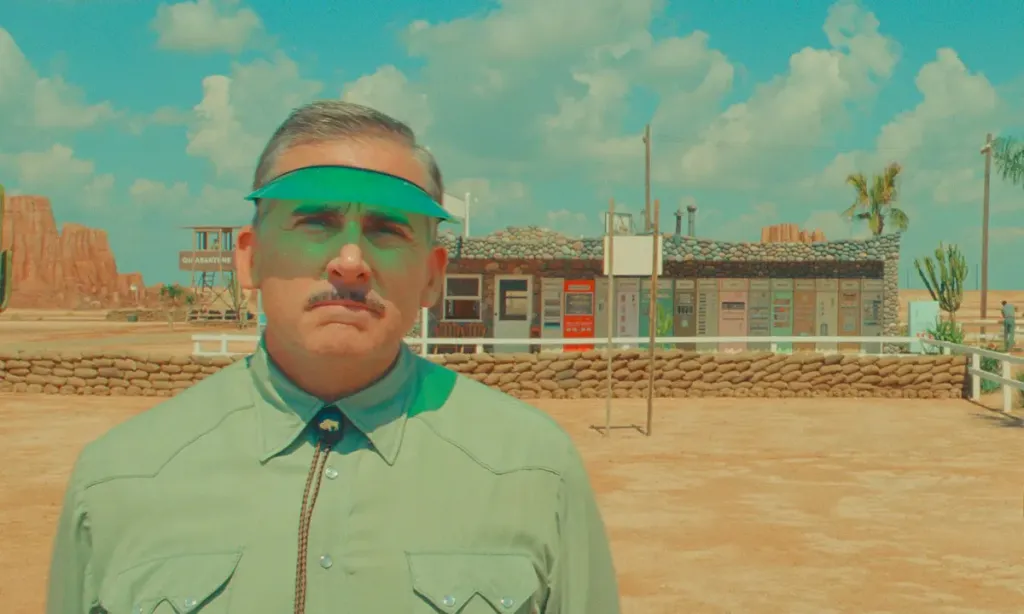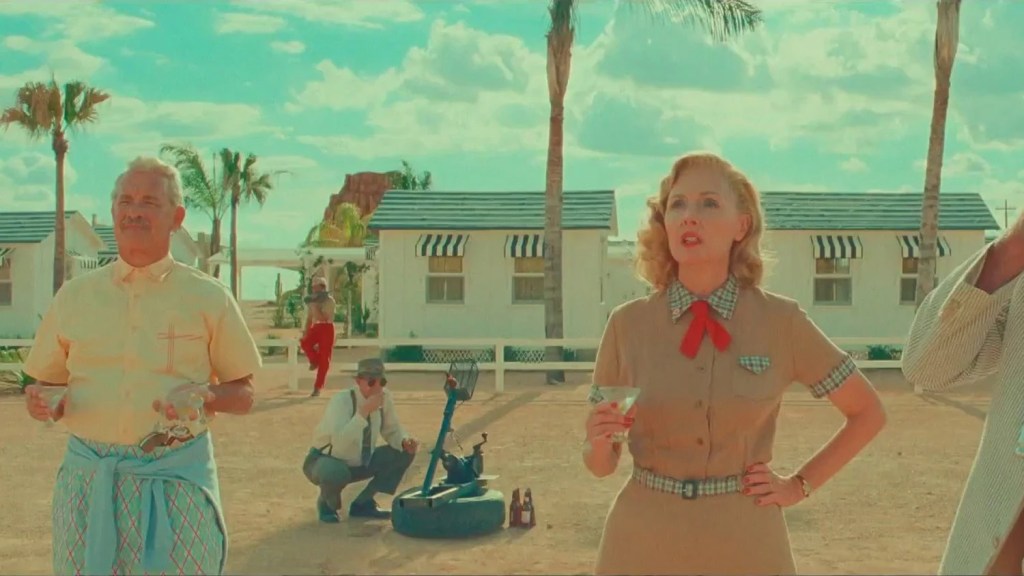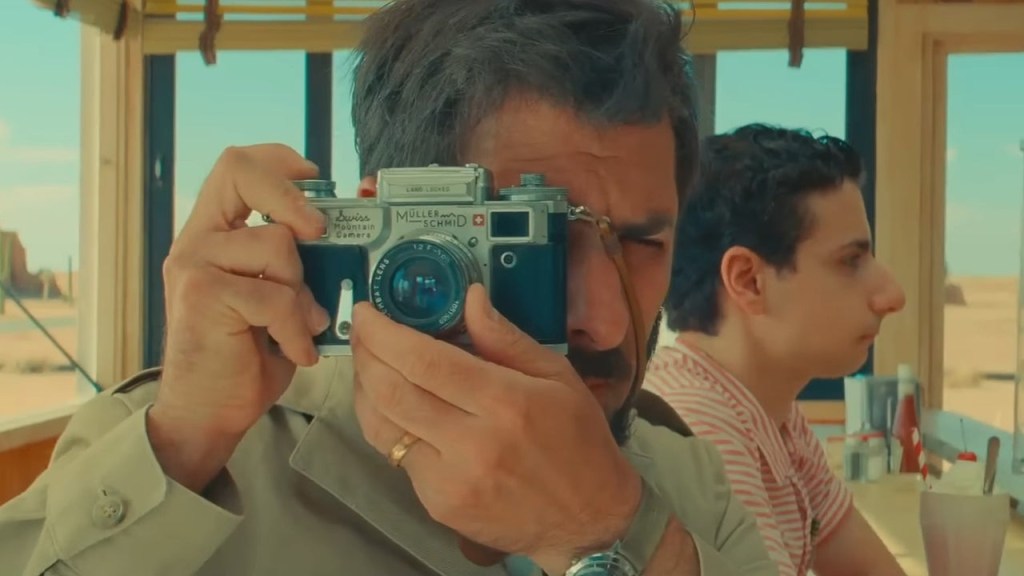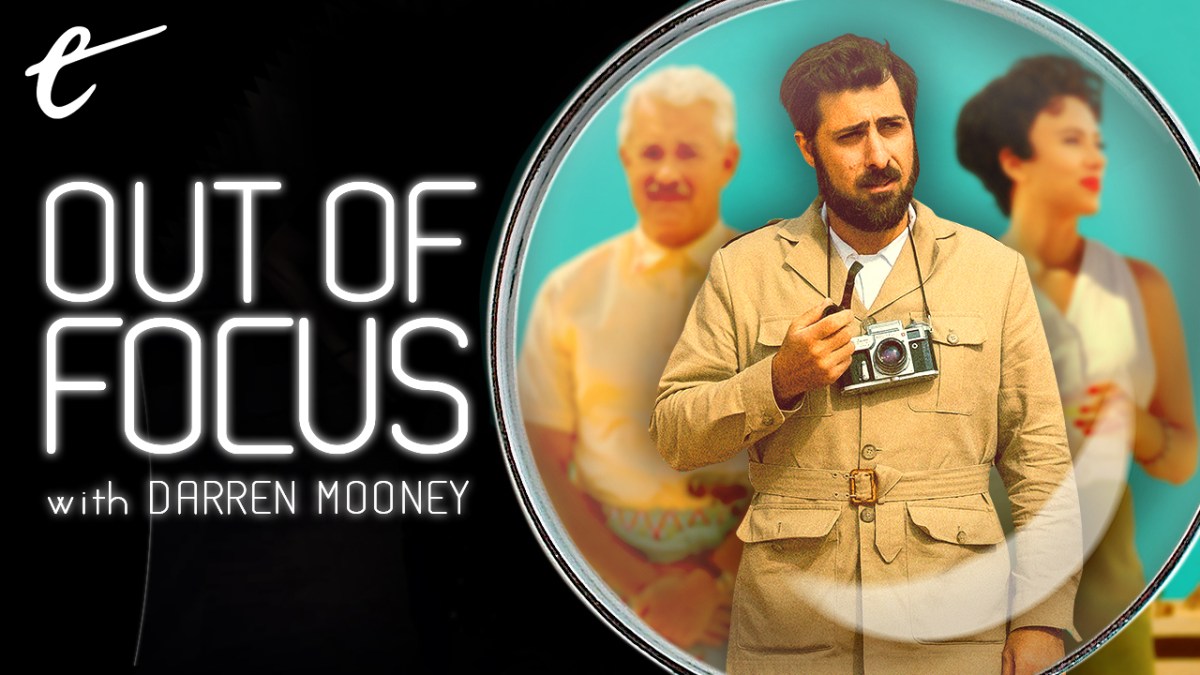Wes Anderson’s Asteroid City is a somewhat difficult film to explain.
As with many of Anderson’s films, Asteroid City has a nesting doll structure. The audience must navigate several layers of narrative before reaching the meat of the story. The film begins in a television studio, with the narrator (Bryan Cranston) explaining that they are about to witness a production of Asteroid City, a play by noted American playwright Conrad Earp (Edward Norton). The play unfolds in the eponymous town, the site of an alien visitation.
Asteroid City presents the play’s reality as fully immersive. These scenes are shot in color, so they cannot be an accurate depiction of the period black-and-white television show. The camera makes it clear that the characters exist in a 360° environment, even if Anderson’s camera only tends to rotate in the director’s trademark right angles and the production design is stylized. The film features effects and scale that, while obviously artificial, could not be convincingly emulated on stage or even on classic television.
However, Anderson repeatedly draws attention to the film’s artifice. The movie’s cast are introduced as the actors playing the roles within the stage play. The narrator articulates the structure of the story before the audience sees it. Before the movie properly begins, Earp explains the mise en scene of the theater production, as the edit draws the audience’s eye to the technical craft used to construct matte paintings or simple sound effects.
Title cards mark act transitions and suggest intermissions. The film also punctuates the staging of the central drama with scenes from the development and production of the stage play: Earp toils away on his typewriter and later visits acting coach Saltzburg Keitel (Willem Dafoe) for advice; Jones Hall (Jason Schwartzman) wins the role of Augie Steenbeck; Mercedes Ford (Scarlett Johansson) flees the production before opening night; director Schubert Green’s (Adrian Brody) marriage collapses.

Even in terms of the film’s visual storytelling, Anderson reminds the audience that they are watching a constructed narrative. While Anderson’s camera is not particularly dynamic, it moves more than usual within Asteroid City, drawing attention to how it controls the viewer’s gaze within shots. At certain points, characters seem aware of the camera and even seem to motivate its movement through pointing or eye movements, as if breaking the fourth wall and addressing the audience.
At several points during the drama, these levels of reality seem to collapse into one another. A conversation between Sandy Borden (Hope Davis) and Midge Campbell (Johansson as Ford) at a communal shower within the play is interrupted when both women spot the narrator, who realizes that he shouldn’t be in the scene. At the climax of the story, struggling to understand what the play is about and if he is playing the role right, Jones breaks character and leaves the theater.
This approach to storytelling is not unusual for Anderson. The Grand Budapest Hotel uses a similar framework to reach its core narrative, introducing the audience to a famed author (Tom Wilkinson) who visited the eponymous institution as a young man (Jude Law). As that younger man, he struck up a relationship with the proprietor, Zero Moustafa (F. Murray Abraham), who shared the story of his own adventures as a young bellhop (Tony Revolori), who worked for Gustave H. (Ralph Fiennes).
The French Dispatch is structured like an edition of the eponymous magazine. It is an anthology, following a set of reporters as they submit their stories for publication. Herbsaint Sazerac (Owen Wilson) offers a cycling tour of Ennui-sur-Blasé; J.K.L. Berensen (Tilda Swinton) delivers a lecture on incarcerated artist Moses Rosenthaler (Benicio del Toro); Lucinda Krementz (Frances McDormand) profiles student revolutionaries; Roebuck Wright (Jeffrey Wright) talks to a chat show host (Liev Schreiber) about the art of culinary detection.

In each case, Anderson shifts the film’s style to underscore the transition, to draw the audience’s attention to how they are venturing deeper into a given story. Anderson shifts aspect ratios between his framing devices and will often transition between black-and-white and color. Even the medium being represented can shift — television, lecture, stage play. Anderson wants the audience to understand that they are watching something constructed. These aren’t objective representations of reality, but instead a shifting window on the world.
This makes sense. Anderson is an auteur with a very distinctive visual style. The production design on his movies is heightened, eschewing realism or verisimilitude in favor of something more abstract. If Tim Burton’s distinctive visual style made him “baby’s first auteur” for Gen X moviegoers — a filmmaker with an aesthetic strong and unique enough to serve as a clear demonstration of what a director actually brings to their project — then Anderson occupies a similar space for the next generation.
Had AI art emerged two decades earlier, it is likely the internet would have been inundated with fake trailers for Star Wars, Lord of the Rings, or Avatar as imagined by Tim Burton rather than Wes Anderson. Anderson’s distinct aesthetic — his deadpan wit, his preference for pastels, his center-framing, his symmetrical composition, his model works, his dolly shots — is something that even a casual viewer can recognize as the product of a singular artist. One can look at a frame from a Wes Anderson movie and know it is from a Wes Anderson movie.
However, this is one reason why those synthetic computer-generated facsimiles of Anderson’s style are so frustrating, even beyond the fact that they seem to owe more to the Saturday Night Live sketch “The Midnight Coterie of Sinister Intruders” than they do to any of the director’s actual films. More to the point, they miss the intentionality of Anderson’s technique. More than that, Anderson is a filmmaker whose work exists in stark opposition to this mode of content creation.

To put it simply, Anderson wants the audience to understand that art does not exist in a vacuum. It cannot exist independently of the people who create it. It cannot be synthesized by algorithms or generated as content. Almost every frame of Anderson’s work is designed to remind the viewer that they are something crafted by a human being, an individual with a point of view and an emotional center. Stories are shaped by the people who tell them, as a way to make sense of the world.
One of the most persistent criticisms of Anderson’s work is that it is “intentionally crafted to create a sense of emotional distance” between the audience and the film, and the audience can often “feel as disconnected as the characters are” within these larger narratives. However, Anderson has always been an achingly sincere filmmaker. His characters are often candid about their emotional vulnerabilities and their difficulties navigating a world that is complicated and contradictory.
Even within Asteroid City, the movie’s formalism allows minor characters the opportunity to express surprisingly rich inner lives. In another movie, characters would spend whole monologues navigating the contradictions that astronomer Dr. Hickenlooper (Tilda Swinton) articulates in her brief observation, “I never had children, but sometimes I wonder if I wish I should have.” General Grif Gibson (Jeffrey Wright) turns a prize presentation into a moving meditation on two generations of military service.
More than that, Anderson presents the creation of art as an expression of a fundamental human curiosity that reverberates through the narratives themselves. Characters in Asteroid City are trying to understand their place in the world, often through the creation of art. Green takes to living backstage at the theater following his divorce from his wife Polly (Hong Chau) and takes her advice on Midge and Augie’s relationship. The actor playing the alien within the play (Jeff Goldblum) insists that the alien is “a metaphor,” but he has no idea for what.

This is true even within the play. Augie is a photographer. Midge is an actor. Hickenlooper looks to the stars. The children in the town are scientists. These are all modes of making sense of the world. Following the death of his wife, Augie wonders if he can play the role of sole parent to his children, just as Jones breaks character at the climax of the play to ask Green if he is playing the role of Augie correctly. Asked to explain Asteroid City the play, Earp states that it is “about infinity and I don’t know what else.” He is figuring it out as much as anyone.
The characters in the play don’t understand the universe, and the characters outside the play are just as confused. Mechanic Hank (Matt Dillon) cannot explain why Augie’s car broke down. Asked what the alien might offer humanity, Augie’s son Woodrow (Jake Ryan) suggests, “The meaning of life; maybe there is one.” Looking to understand Augie, Jones has a chance encounter with the actress who played Augie’s wife in an earlier draft (Margot Robbie), who recites her only scene by way of answer, a scene cut from the play.
Anderson’s themes feel particularly timely. It feels like the multimedia landscape is increasingly hostile to the idea of creators. One of the underlying anxieties of the current writers’ strike is that studios might turn to AI to replace human storytellers. There is a broader sense that both studios and online fandoms have become antagonistic to the idea of auteurs, particularly working on films with high budgets and high profiles. These projects shouldn’t be made by algorithms, but by people.
Of course, this anxiety extends beyond show business. The French Dispatch was a love letter to long-form journalism as an artform unto itself, with Anderson inspired by the real-world publication The New Yorker. Journalism is facing these same existential threats. Journalists have been turned into political targets, branded as “the enemy of the people.” Certain press outlets have signaled an intent to use AI to generate content, devaluing the work of individual writers and journalists as storytellers.
At a time when those who create art are increasingly devalued and overlooked, Anderson’s films ask the audience to consider these works as constructed objects. The director certainly didn’t make Asteroid City as a response to the attempts to reduce his craft to an AI-friendly meme, and to argue that specific case would undermine the film’s more profound consideration of the human condition. Still, Asteroid City is a reminder of how such meditations are fundamentally and profoundly human.





